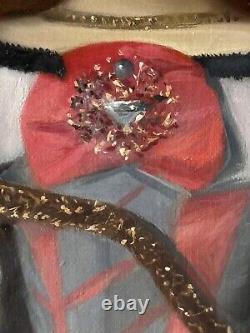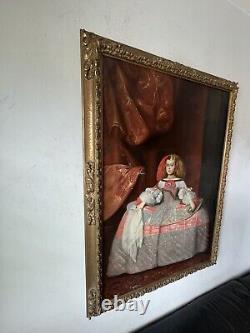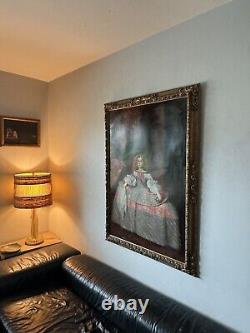
- Index
- Artist
- Antonio Devity (4)
- Charles Levier (3)
- Henri Matisse (7)
- Illegible (5)
- Illegible Signature (58)
- Jean Daumier (3)
- Julius Polek (3)
- L. Sihiinzel (4)
- London (4)
- Maren (3)
- Max Ernst (6)
- Reinald Morgen (3)
- Remedios Varo (7)
- Salvador Dali (6)
- See Description (9)
- T.bailey (4)
- Unknown (109)
- Unsigned (7)
- Yu Liang Jin (4)
- Yu Yin Xin (4)
- Other (919)
- Framing
- Material
- Size
- Theme
- Type
Large Antique Famous Woman Portrait Oil Painting Queen Margaret Theresa Spain


























EXTRAORDINARY ANTIQUE SPANISH IMPRESSIONIST OIL PAINTING ON CANVAS BY REVERED SPANISH PAINTER JOSE SANZ. THIS WORK DEPICTS AN ICONIC PORTRAIT OF QUEEN MARGARET THERESA OF SPAIN (JULY 1651- MARCH 1673). ADORNED IN REGAL ATTIRE FIT FOR A MONARCH, QUEEN MARGARET THERESA COMMANDS ATTENTION AS SHE GAZES CONFIDENTLY AT THE VIEWER. HER CLOTHING, A SYMPHONY OF RICH FABRICS AND INTRICATE EMBROIDERY DRAPES ELEGANTLY AROUND HER FIGURE. THE ARTIST'S MASTERFUL BRUSHWORK CAPTURES THE QUEEN WITH REMARKABLE DETAIL.
THIS PAINTING IS MORE THAN JUST A REPRESENTATION OF A HISTORIC FIGURE; IT IS A WINDOW INTO THE WEALTH AND POWER OF THE SPANISH MONARCHY. SIGNED AND DATED 1966 BY JOSE SANZ OF MADRID SPAIN ON THE VERSO. DIMENSIONS: 52" H x 37" W. PROVENANCE: PRIVATE COLLECTION, BEVERLY HILLS CALIFORNIA. Margaret Theresa of Spain (Spanish: Margarita Teresa, German: Margarete Theresia; 12 July 1651 - 12 March 1673), was by marriage, Holy Roman Empress, Queen of Germany, Archduchess of Austria and Queen of Hungary and Bohemia.She was the daughter of King Felipe IV of Spain and the older full-sister of King Carlos II of Spain, the last of the Spanish Habsburgs. She is the central figure in the famous Las Meninas by Diego Velázquez. She was the subject of many of his later paintings. She was also a half-sister of Maria Theresa of Austria (the wife of Louis XIV of France) In Austria she was known as Margarete Theresia. She is her father's favourite child.
He called her "my joy". She was an Archduchess of Austria by birth as well as by marriage and an Infanta of Spain. She was Margarita Teresa of Austria, but not "of Spain" due to being a member of the House of Habsburg. She married her uncle, Leopold I, Holy Roman Emperor an on 5 December 1666, the solemn entry of the Infanta in Vienna took place and the official marriage ceremony was celebrated seven days later, on 12 December. Throughout their marriage Margarita Teresa called her husband uncle.Infanta Margarita Teresa in a Pink Dress is a 1660 oil on canvas portrait of Margaret Theresa of Spain by the Spanish painter Diego Velázquez, though his identification as its author is not considered secure. It is now in the Prado Museum in Madrid. It was generally considered to be the last work in his oeuvre, with the dress by Velázquez himself and the head (left unfinished on Velázquez's death) and the bottom of the curtains completed by his pupil Juan Bautista del Mazo. However, recent studies by experts suggest it may be entirely by Mazo.
The Prado Museum currently assigns the work to Mazo. Its subject was the royal most frequently portrayed by Velázquez, also appearing in his Las Meninas and Infanta Margarita Teresa in a Blue Dress. In the final years of his life he spent long periods producing portraits of her to send to the Austrian court for political reasons and in response to certain matrimonial arrangements made between the two courts. Infanta Margarita Teresa in a Blue Dress is still in Vienna as are two 1652-53 portraits of her aged one or two in a silver and pink dress. A replica of the latter of the two, with variations, is in the Liria Palace in Madrid, though this is attributed to another painter.Until the 19th century the painting was misidentified as a portrait of Infanta Maria Theresa of Spain, child of Philip IV of Spain's first marriage (with Elisabeth of France) and later wife of Louis XIV of France. In an 1872 catalogue by the painter Pedro de Madrazo, then the Prado's director, it was still misidentified in this way.
Later research revealed that it actually is Margaret Theresa, child of Philip IV's second marriage to Mariana of Austria. It was especially admired by the Impressionists and painters of subsequent movements for the lightness of its stroke.
